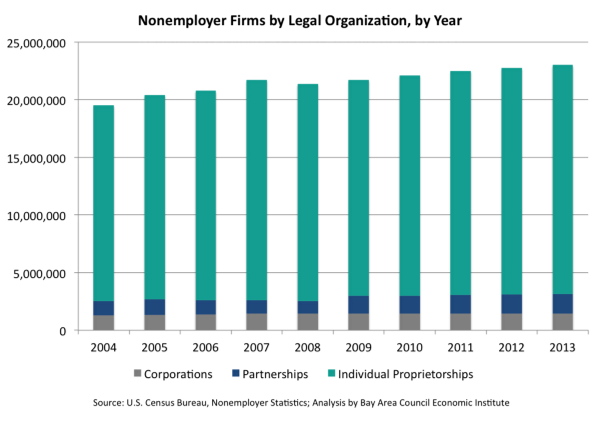In 1996, movie rental stores were ubiquitous and cell phones were few and far between. The modern Internet was unimaginable – web pages were largely text-based and could take almost a minute to load. Google wouldn’t even exist for another two years.
We’ve made incredible strides since then, and our infrastructure has made incredible strides too. Moving forward, California must continue to support and expand the infrastructure needed for the 21st century and beyond.
Read below for just some of the ways that investments in 21st century communications infrastructure will create huge economic and social benefits for all Californians.
Energy
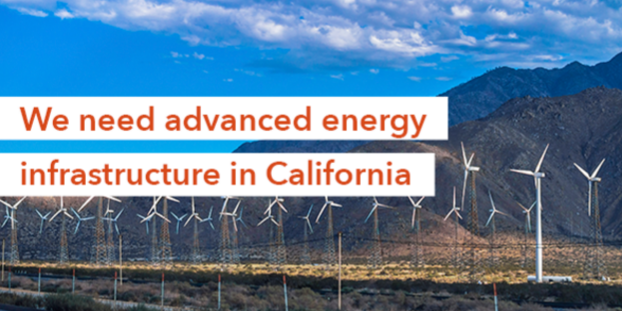
In California, 21st century infrastructure is needed to maintain access to reliable, affordable electricity. “Smart grid” describes a next-generation electrical system that is typified by the increased use of communications and information technology in the generation, transmission, delivery, and consumption of energy. Smart grids are made possible by two-way communication technology and computer processing that has been used for decades in other industries. With this communications infrastructure, California can reduce carbon emissions and energy costs at the same time.
Learn more by reading the full report
California’s Future
For California to realize the social and economic benefits of emerging and future communications technoogies, it must have an equally advanced communications infrastructure to support them. As other states and countries take steps to facilitate network upgrades, California’s communications infrastructure will need to be updated or risk being unprepared for future requirements placed upon it.
With the coming wave of digital demand, investments in 21st century infrastructure are needed to seize the benefits that new communications technologies offer. To meet these shifting demands and to keep California economically competitive, policies can be put in place that will give communications providers greater flexibility to innovate and reduce barriers to investment.
For details, read the full report
In 1996, movie rental stores were ubiquitous and cell phones were few and far between. The modern Internet was unimaginable – web pages were largely text-based and could take almost a minute to load. Google wouldn’t even exist for another two years.
We’ve made incredible strides since then, and our infrastructure has made incredible strides too. Moving forward, California must continue to support and expand the infrastructure needed for the 21st century and beyond.
Read below for just some of the ways that investments in 21st century communications infrastructure will create huge economic and social benefits for all Californians.
Public Services and Safety
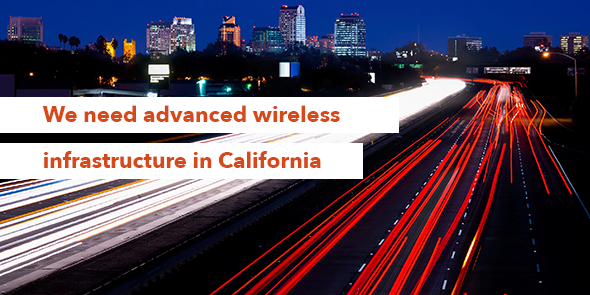
Smart city infrastructure relies on connectivity and can create efficiencies in water, power, transportation, and waste management. For example, Cleveland and Cincinnati have implemented successful waste-collection programs with the help of radio-frequency identification (RFID) tags on garbage and recycling bins, cutting operating costs and increasing recycling rates.
In the future, smart city sensors installed across urban infrastructure will create enormous quantities of data. Optimizing such data can vastly improve government services and reduce inefficiency, freeing government resources to be repurposed to other priorities. Such data could also be utilized for consumer applications, from painlessly locating available parking spaces to serving as the backbone for autonomous vehicles.
Learn more by reading the full report
California’s Future
For California to realize the social and economic benefits of emerging and future communications technoogies, it must have an equally advanced communications infrastructure to support them. As other states and countries take steps to facilitate network upgrades, California’s communications infrastructure will need to be updated or risk being unprepared for future requirements placed upon it.
With the coming wave of digital demand, investments in 21st century infrastructure are needed to seize the benefits that new communications technologies offer. To meet these shifting demands and to keep California economically competitive, policies can be put in place that will give communications providers greater flexibility to innovate and reduce barriers to investment.
For details, read the full report
In 1996, movie rental stores were ubiquitous and cell phones were few and far between. The modern Internet was unimaginable – web pages were largely text-based and could take almost a minute to load. Google wouldn’t even exist for another two years.
We’ve made incredible strides since then, and our infrastructure has made incredible strides too. Moving forward, California must continue to support and expand the infrastructure needed for the 21st century and beyond.
Read below for just some of the ways that investments in 21st century communications infrastructure will create huge economic and social benefits for all Californians.
Health

Better infrastructure means doctors can provide better patient care. Data captured from emerging non-invasive health-monitoring sensors, such as disposable bandages and ingestible pills, will support expanded mobile-based care, self-care, and more accurate diagnostics—all of which have the potential to both improve care and reduce costs, and can only be achieved through improved network connectivity. When paired with remote physician monitoring, these innovations could save the US healthcare system $197 billion over the next 25 years.
In the future, officials envision a reduction in physician visits for elderly patients and persons with mobility challenges, as those visits could be replaced by video conference over high-speed internet connections. Doctors and various medical units will also be able to share large files, such as retina scans, x-rays, and vascular imaging that could speed diagnosis and lower patient costs.
Learn more by reading the full report
California’s Future
For California to realize the social and economic benefits of emerging and future communications technoogies, it must have an equally advanced communications infrastructure to support them. As other states and countries take steps to facilitate network upgrades, California’s communications infrastructure will need to be updated or risk being unprepared for future requirements placed upon it.
With the coming wave of digital demand, investments in 21st century infrastructure are needed to seize the benefits that new communications technologies offer. To meet these shifting demands and to keep California economically competitive, policies can be put in place that will give communications providers greater flexibility to innovate and reduce barriers to investment.
For details, read the full report
In 1996, movie rental stores were ubiquitous and cell phones were few and far between. The modern Internet was unimaginable – web pages were largely text-based and could take almost a minute to load. Google wouldn’t even exist for another two years.
We’ve made incredible strides since then, and our infrastructure has made incredible strides too. Moving forward, California must continue to support and expand the infrastructure needed for the 21st century and beyond.
Read below for just some of the ways that investments in 21st century communications infrastructure will create huge economic and social benefits for all Californians.
Education
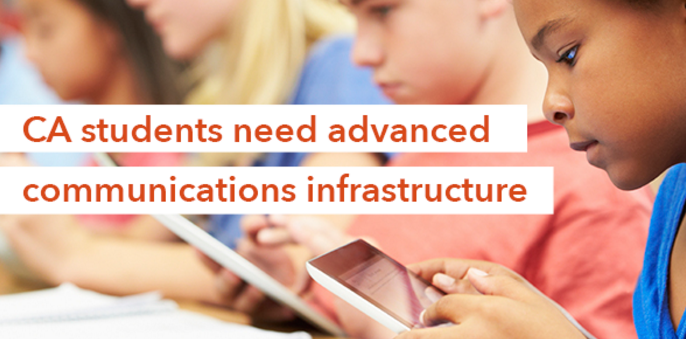
Through both technology in the classroom and online learning opportunities, 21st century infrastructure is enhancing education. In 2013, 78 percent of students and 83 percent of faculty and staff in the US brought a personal device to the classroom and used the campus network for access to the Internet. However, more than 50 percent of teachers say that slow or unreliable Internet access presents obstacles to their use of technology in the classroom. Additionally, 63 percent of public schools in the US do not have adequate Internet infrastructure to support digital learning.
In the future, 21st century communications infrastructure will expand access to educational materials, improving student tracking and making it possible to tailor lessons to individual pupils. This type of learning also frees up time for teachers to spend more time interacting one-on-one with students.
Learn more by reading the full report
California’s Future
For California to realize the social and economic benefits of emerging and future communications technoogies, it must have an equally advanced communications infrastructure to support them. As other states and countries take steps to facilitate network upgrades, California’s communications infrastructure will need to be updated or risk being unprepared for future requirements placed upon it.
With the coming wave of digital demand, investments in 21st century infrastructure are needed to seize the benefits that new communications technologies offer. To meet these shifting demands and to keep California economically competitive, policies can be put in place that will give communications providers greater flexibility to innovate and reduce barriers to investment.
For details, read the full report
In 1996, movie rental stores were ubiquitous and cell phones were few and far between. The modern Internet was unimaginable – web pages were largely text-based and could take almost a minute to load. Google wouldn’t even exist for another two years.
We’ve made incredible strides since then, and our infrastructure has made incredible strides too. Moving forward, California must continue to support and expand the infrastructure needed for the 21st century and beyond.
Read below for just some of the ways that investments in 21st century communications infrastructure will create huge economic and social benefits for all Californians.
Agriculture
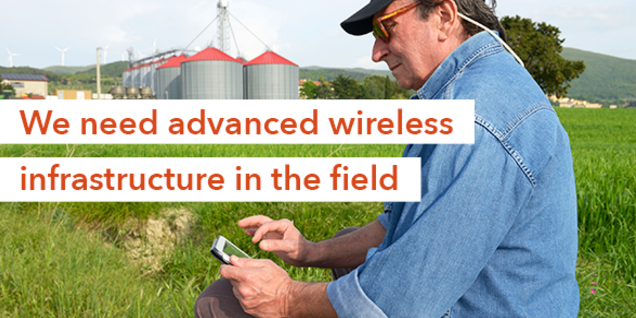
California grows enough food to feed the world, but has a volatile climate and experiences droughts that can last years. For example, in 2014, one of the driest years on record, the drought resulted in a net water shortage of 1.5 million acre-feet, which cost statewide agriculture $2.2 billion and the loss of 17,100 seasonal and part-time jobs.
However, new advances in precision-agriculture, driven by 21st century communications technology, promise to yield huge efficiencies in California’s water usage. Field sensors and drones are beginning to provide farmers with precise weather, crop, soil, and air quality data that can be used to greatly improve use efficiency and reduce runoff.
Learn more by reading the full report
California’s Future
For California to realize the social and economic benefits of emerging and future communications technoogies, it must have an equally advanced communications infrastructure to support them. As other states and countries take steps to facilitate network upgrades, California’s communications infrastructure will need to be updated or risk being unprepared for future requirements placed upon it.
With the coming wave of digital demand, investments in 21st century infrastructure are needed to seize the benefits that new communications technologies offer. To meet these shifting demands and to keep California economically competitive, policies can be put in place that will give communications providers greater flexibility to innovate and reduce barriers to investment.
For details, read the full report
by Tracey Grose & Patrick Kallerman
Last Tuesday, a U.S. District judge in San Francisco granted class-action status to a lawsuit brought by three California Uber drivers. The case could ultimately decide one of the biggest unanswered questions of the so-called “1099 economy”: do we have an independent contractor problem? Are all participants (in this case, Uber drivers), independent contractors, or do some qualify as actual employees? Are 1099 jobs inherently subpar, or do some models offer new flexibility to the benefit of both worker and employer?
The new technology platforms that bring greater flexibility to the marketplace by enabling short-term and task-based work are diverse, as are the business and earnings models underlying them. During an era of wage stagnation and growing income disparity, and with increasing numbers of businesses and services relying on independent contractors, how the courts decide on this matter could have immense consequences for work and business models in the future. At the same time, we know surprisingly little about this segment of the economy: how big it is, or how fast it’s growing. Better understanding the changing nature of work is essential to informing any policy action targeting an increasingly diverse field of new work models.
The 1099 Economy: Hot or Not?
The recent growth of the segment of the labor force made up of contract workers — sometimes known as freelancers, gig-workers, supertemps, or 1099 workers (“1099” refers to the IRS Form 1099-MISC used by independent contractors) — was initially described as a tidal wave. Reports speculated on a massive rise of individuals choosing contract work over traditional arrangements, an increasing reliance on this work by businesses of all sizes, and how the dependence on contract work will reshape the economy and careers.
A second wave of commentary asked whether this trend was of any consequence at all. Recent reports have questioned the sustainability of the gig economy, raised concerns about the implications for individuals of on-demand work, and even suggested that individuals are less likely than ever to be self-employed or to hold multiple jobs.
However, both narratives are oversimplifications inconsistent with close analysis of the data.
The Contingent Workforce Goes Underground
Originally known as “contingent workers” — a term coined in 1985 by labor economist Audrey Freedman — part-time, on-call, and self-employed individuals have consistently represented a sizable portion of the labor force. Census estimates from the 1990s and early 2000s put its share at a steady one-third of workers.
When the source of these data — the Contingent Work Supplement — was discontinued in 2005, statistics on this workforce became surprisingly difficult to find. So much so that Senator Mark Warner — who is emerging as the leading champion of policy reform in this area — has requested that the Census Bureau, the Bureau of Labor Statistics, and the IRS produce additional data to help inform the debate.
In the absence of more detailed data, many have pointed to the sharp rise in the Census Bureau’s Nonemployer Statistics as evidence of the growing 1099 economy. Defined as individual proprietorships, partnerships, or corporations with no employees, the number of nonemployer firms has increased by nearly 18 percent since 2004, compared to a 3.5 percent increase in payroll employment. Patterns vary by industry sector with Utilities, Transportation and Warehousing, and Real Estate topping growth in nonemployer firms last year. This story becomes even more interesting when broken down by occupation.
While the Nonemployer Statistics may be a reasonable measure, they do exclude certain individuals and aspects of the 1099 economy. For example, firms and individuals only show up in the Nonemployer Statistics once they have earned over $1,000 in a year on the theory that these activities are more likely to be hobbies rather than businesses. These data also lack insight into the volume of gigs being performed. A more reliable way to gauge the size of this segment of the labor force and the number of gigs worked is through Internal Revenue Service data.
An Explosion in 1099s?
The chart below uses previously unanalyzed data obtained from the IRS’s Office of Research and reflects the growth in 1099s vs. W-2s, indexed to their levels in 1989. Interestingly, we see that growth in the number of issued 1099s had previously been very strong primarily following the recessions of 1990, 2001, and 2007. However, since the end of the latest recession in 2009, the growth has steadily continued, whereas the rise in W-2s has come in fits and starts.
So why are so many more 1099s being issued? While it is true that any single individual can receive multiple 1099s, the rising number of 1099s means either the same number of individuals is taking on more “gigs,” more individuals are joining the 1099 economy, or both. Again, the story is mixed. Coming out of the last downturn, the San Francisco Federal Reserve points out that involuntary part-time employment has remained stubbornly high, and individuals aren’t finding as much work as they need. Platforms like Lyft, Uber, TaskRabbit, and Instacart have made participating in the 1099 economy much easier, a trend that has also shown up in the Nonemployer Statistics. The new flexibility that these platforms offer also enables new earning models for people with limited availability or who are between pursuits.
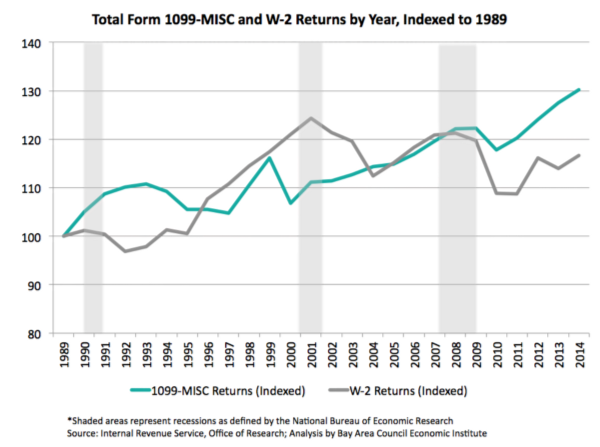
Technology continues to be a formidable driver of economic change, and the tools we have for tracking change will always lag behind. There is more to learn, and what we learn about the nature of the contingent economy and the changing nature of work generally must drive our policy responses. Precipitous legal and regulatory responses risk squelching innovation and growth without the knowledge of whether these interventions will have positive outcomes.
